Musee du quai Branly Green Wall
• 2006
• Paris, France
• Living Wall
• 8600 sq.ft.
• 100% slope
• Accessible, Open to Public
Architect: Jean Nouvel
Green Wall Designer & Installation: Patrick Blanc
Green Wall System: Mur Vegetal
Located close to the Eiffel Tower in Paris France, the Quai Branly features indigenous art, cultures and civilizations from Africa, Asia, Oceania, and the Americas. The museum complex contains several buildings, and a garden. The green wall, or the "living wall" (200m long by 12m tall) on part of the exterior of the museum was designed and planted by Patrick Blanc. Created in 2006, with over 200 species of plants, the wall extends from the sidewalk up
According to Patrick Blanc’s Vertical Garden system:
The Vertical Garden is composed of three parts: a metal frame, a PVC layer and a layer of felt.
• The metal frame is hung on a wall or can be self-standing. It provides an air layer acting as a very efficient thermic and phonic isolation system.
• A 1 cm .-thick PVC sheet is riveted to the metal frame. This layer brings rigidity to the whole structure and makes it waterproof.
• A felt layer, made of polyamide, is stapled on the PVC. This felt is rotproof and its high capillarity allow an homogeneous water distribution. The roots grow on this felt.
• Plants are installed on this felt layer as seeds, cuttings or already grown plants. The density is about thirty plants per square meter.
• The watering is provided from the top. Tap water must be supplemented with nutrients.
• Watering and fertilisation are automated.
• The whole weight of the Vertical Garden , including plants and metal frame, is lower than 30 kg per square meter. Thus, the Vertical Garden can be implemented on any wall, without any size or height limitation.
Sources: Vertical Garden: Patrick Blanc. www.verticalgardenpatrickblanc.com
Goodwill-Milgard Center, Tacoma Washington
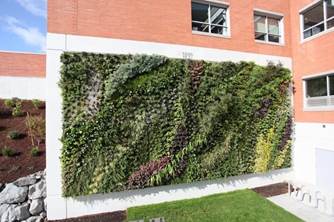
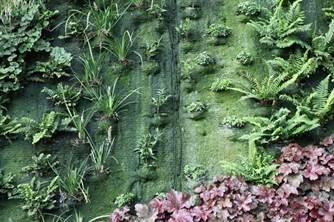
A new vertical garden at the Goodwill-Milgard Work Opportunity Center in Tacoma features about 100 different varieties of plants installed between layers of felt and nourished by water. The garden wall, which measures 20 by 40 feet, is "a new iconic image" for the city, says Matthew Erlich of Tacoma Goodwill.1 The green wall was unveiled in September 2009. Designed by Patrick Blanc, a French botanist, artist and leader in living wall installations; the 800-square-foot vertical garden is sited on a new building visible from busy Tacoma Avenue. Plants are installed in pockets slit into a double layer of felt. Water, not soil, is the growing agent.
Thousands of multihued foliage plants run in diagonal ribbons across its 20-by-40-foot surface. A double layer of felt is mounted on top of PVC piping, which is layered on top of a metal frame attached to the building. Slits are cut into the felt to make little planting pockets. Unbelievably, even woody plants are planted this same way, their roots surviving (so far, anyway) in about a half-inch-thick layer of felt.
A drip irrigation system runs across the top of the wall and in a horizontal band halfway down. Water and fertilizer from the system "bleed" through the felt to keep the plants perpetually moist and nourished. There's a freeze switch to stop the irrigation on the coldest days of winter so the garden doesn't turn into a solid wall of ice. The maintenance of the wall is a pruning of the wall, twice a year, with a cherry picker.
The wall represents Blanc’s first exterior piece in the North America. Some publications have described it as “big news,” and headlined it as a “new city icon” for Tacoma. Program participants who come to the Milgard center for training have said represents new possibilities such as what they look to accomplish through the job training and placement services Goodwill provides. 2
The Goodwill-Milgard Work Opportunity Center and its green wall can be found at 714 S. 27th St. in Tacoma (www.tacomagoodwill.org).
Sources:
1. Easton, Valerie. http://seattletimes.nwsource.com/html/pacificnw/2010642515_pacificplife10.html?cmpid=2628
2.Tacoma Goodwill Living Wall: http://tacomagoodwill.org/about/mwoc/living-wall/
Anthropologie Huntsville, Alabama
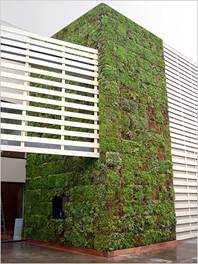
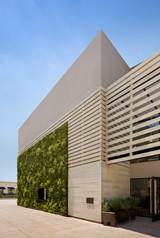
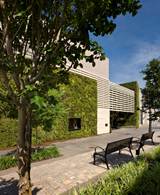
Example of the Economic, Aesthetic, and Environmental Benefit
Designer: EOA Elmslie Osler Architect, www.eoainc.com
Location: Huntsville, Alabama
Project Background:
The vegetative landscape stretches over 186 square meters of the south and southeast walls of the building and is claimed to be one of the largest vegetated facades in North America. The living walls were planted to bloom in the spring and stay lush and green during the winter months. “As the living walls change through the seasons the plant life will bring a natural textural element into the anonymity of the typical suburban lifestyle center. Ultimately the walls help to support an awareness of the environment and establish a more modern way of looking at nature” (source 1)
The Green Wall consists of stainless steel panels that can be custom designed to fit any type of wall or frame. They are a flexible, modular system that can be used on both interior and exterior surfaces, in all climates, and can be removed if maintenace is required. The walls on the Anthropologie facade are made up of soil based 2x2x3 panels of a variety of sedum genus. Typically these type of modular systems have a calculated water management system that has controlled moisture and temperature levels.
Source:
1. http://www.nemetonmagazine.net/blog/?p=339
PNC Bank Building


Designer: Green Living Technologies, Philly Green Wall
Location: Pittsbutgh, Pennsylvania
Project Background:
PNC Bank commissioned the green wall installation in 2009 to establish an innovative way to establish an energy efficient headquarters. Rather than using a typical marketing strategy, the building facade showcases 2,380 square feet of a vegetated, artful wall to display its' PNC logo. “ It is estimated that each of the 602 panels, with 24 plants in each 2x2 square foot space, will offset the carbon footprint of one person” 1 The 30-story building is expected to benefit from the vegetated insulative layer, as it is has the potential to be 25% cooler than ambient temperatures. The 4” inch planting depth of Green Wall Panels contains a variety of geographically sensitive plant types that are expected to maintain seasonal foliage.
The internally controlled irrigation system is water efficient, made up of 9 zones along the wall, watering 15 minutes per week. As an added benefit to the local landscape, the PNC building is an inherently local project, sourcing all of its hardware, plant material and installers from within a 500 mile radius.
Sources:
1. http://www.greenroofs.com/projects/pview.php?id=1078
2. http://www.fastcompany.com/blog/ariel-schwartz/sustainability/pnc-bank-building-largest-green-living-wall-us#
|








